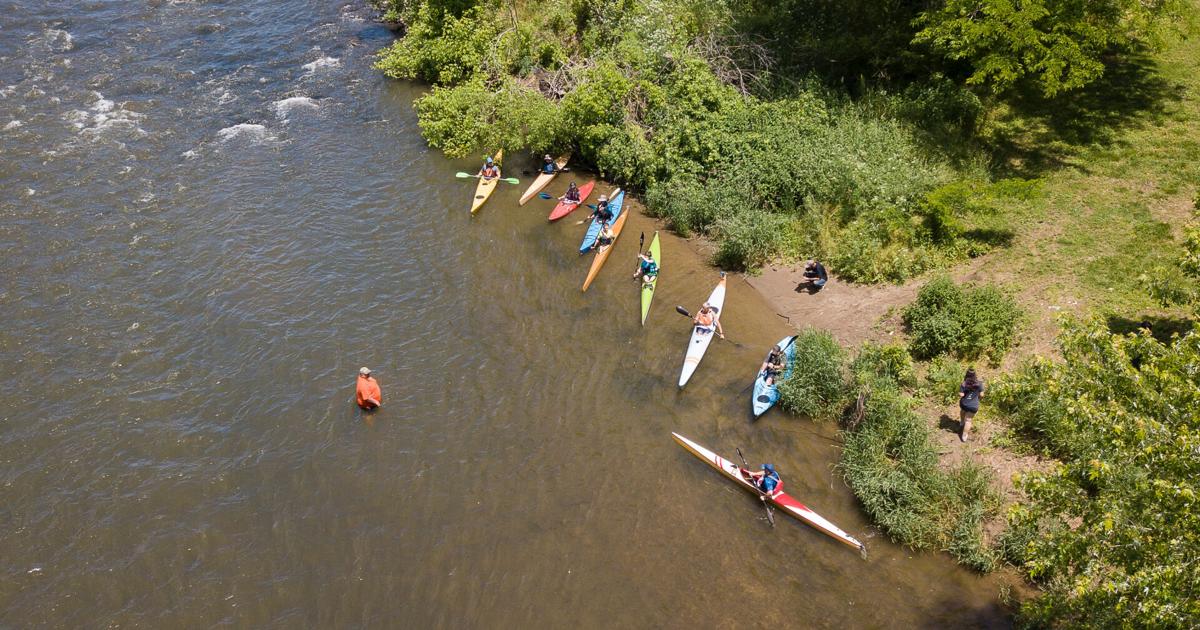
Every few generations, it seems, a new grassroots champion rises to fight for the Conestoga River, Lancaster County’s often beautiful, if still polluted, historic waterway.
Unlike the Susquehanna, which is just passing through on the county’s western boundary, all the Conestoga except its headwaters is contained in the county, and its 62-mile course through its heart drains about half of all waterways.
Still, its place in our hearts has been somewhat schizophrenic. Heck, we couldn’t even decide whether to call it a creek or a river until the federal government declared it a river in 1976. Still, it seems about half the populace of the county refer to it as Conestoga Creek.
Todd Roy, a West Virginia transplant who fell instantly in love with the river when he first dipped a paddle into it 17 years ago, is the latest to pull together a plan to make the river more accessible to the public while improving its water quality and scenery.
Roy’s nonprofit, 135-member Conestoga River Club and the Lower Susquehanna Riverkeeper Association have cobbled together an impressive $60,000 in grants to draw up a comprehensive plan for rehabilitating the river and its inadequately equipped paddling water trail for 30 miles, from Brownstown to the river’s marriage with the Susquehanna at Safe Harbor.
With the aid of consultants and the public, the plan will recommend more, improved and safer boat launches and passage on the river for recreation.
But recreation is hardly the entire focus.
Roy would like to see more use of the river spark interest, setting the stage for funding of conservation projects that dovetail with existing efforts to address agriculture and urban stormwater runoff, as well as combined sewer overflow pollution in Lancaster city.
Think vegetative buffers along the river and feeder streams, tree plantings and removal of invasive plants that increasingly choke the river’s banks.
“Our message is, the river belongs to us, and that means it’s our responsibility to care for it,” Roy says. “The first effort is to make it more accessible and usable and highlight the need to get more people invested.”
The East Petersburg resident’s rhetoric stirs up the ghost of the late Lancaster County businessman and conservationist Earl F. Rebman, who fought valiantly against the despoiling of the Conestoga and to open up public access in the 1950s, 1960s and 1970s.
Rebman and the Conestoga Valley Association group he founded called for the elimination of soil runoff and stream pollution — raw sewage dumped into the river was rampant at the time — and the preservation and restoration of historic sites along the river.
The heart of the plan was to establish a riverside road from Lancaster city all the way to Safe Harbor, peppered with public parks, open spaces and vistas along the way.
“The Conestoga River is not private property. The public must be given a right of way where feasible,” Rebman argued at the time.
Rebman and CVA had some successes in their campaign. Among them: Sewage treatment plants were built, a park was established at Safe Harbor, Rock Ford Plantation was saved and restored and an eyesore car dump was removed from South Duke Street. Short sections of a Conestoga Boulevard were built in Lancaster County Central Park and at Safe Harbor.
Like Rebman, who died in 1983, Roy touts the many nationally significant historical events tied to the Conestoga in making the case for taking better care of the river.
Like Henry E. Leman’s early long rifles made in a riverside factory in Manheim Township and the rails produced for the Pennsylvania Railroad and cannons made for the Union army in the Civil War at the massive foundry at Safe Harbor.
Like the Conestoga covered wagons and “stogie” cigars. Like Robert Fulton’s early experiments with steamboats in the river in what is now Lancaster County Central Park. Like Dr. Ruth Patrick, the iconoclastic scientist from Philadelphia who studied the river’s aquatic insects one summer in 1948 and came up with the then-revolutionary, now-standard method of assessing a waterway’s health by the aquatic insects that live in it.
At the port of Lancaster, near Engleside, one could ride a steamer on the Conestoga Navigation Co. canal to Baltimore and catch a boat on to Europe.
In the 1700s and 1800s, an estimated 400 forges, gristmills and sawmills crowded the river’s banks. The frequent damming converted the river from its original course as a shallow network of braided streams to slackwater ponds. The silt that built up is still being released now in “legacy” sediment that pollutes the river.
The Conestoga was Lancaster city’s first source of public drinking water and ice that served as early refrigeration through the summer. The river produced early hydroelectric power in at least two locations.
Rocky Springs Park, the Lady Gay and Evelyn B. paddleboats, Peoples Bathing Resort and the Conestoga Boulevard driving lane in the Bridgeport area delighted generations of residents on summer days.
“I would argue we have the most historic waterway in the nation, hands down,” Roy says. “It informed some pretty serious history across the nation.”
Much has been done since Rebman’s efforts to clean the Conestoga. Modern sewage-treatment plants and far-reaching efforts to restore the Chesapeake Bay have brought down runoff of pollutants.
But the river still runs chocolate brown after even moderate rains and most of its 62 miles remain on the state’s impaired list for recreation. In 1963, the U.S. Geological Survey measured 84,000 tons of washed-off topsoil in the river. Today, that has been reduced to 52,604 tons a year as estimated by the Susquehanna River Basin Commission but is still a concern.
Roy was asked what he wants the Conestoga River to be in 15 years. “I want to see a greater sense of community pride and stewardship for the river,” he replied. “I want to see that it is not as dangerous to interact with as it is now with combined sewer overflows and ag runoff.
“I want to see 7- and 8-year-old boys and girls playing in the river and having fun and waving at the fishermen.”
Ad Crable is an LNP | LancasterOnline outdoors writer. Email him at acrable@lnpnews.com.

![A new advocate rises to fight for the Conestoga River [column] - LNP | LancasterOnline](https://www.gaynewstoday.com/wp-content/uploads/2022/07/a-new-advocate-rises-to-fight-for-the-conestoga-river-column-lnp-lancasteronline-696x366.jpg)






